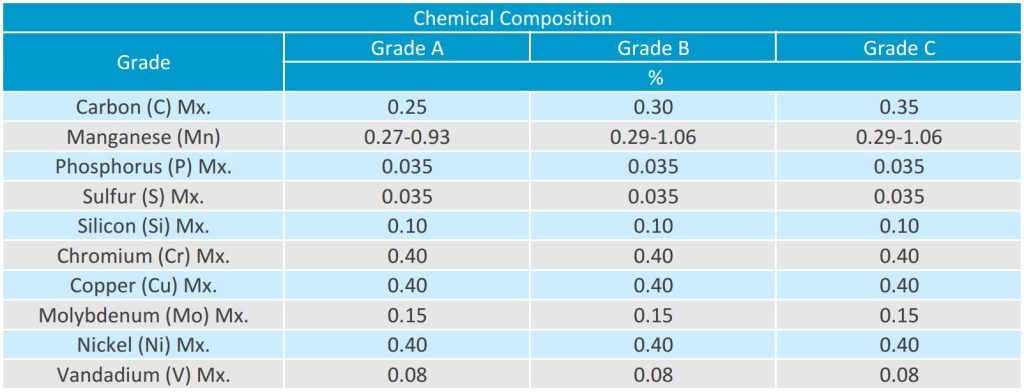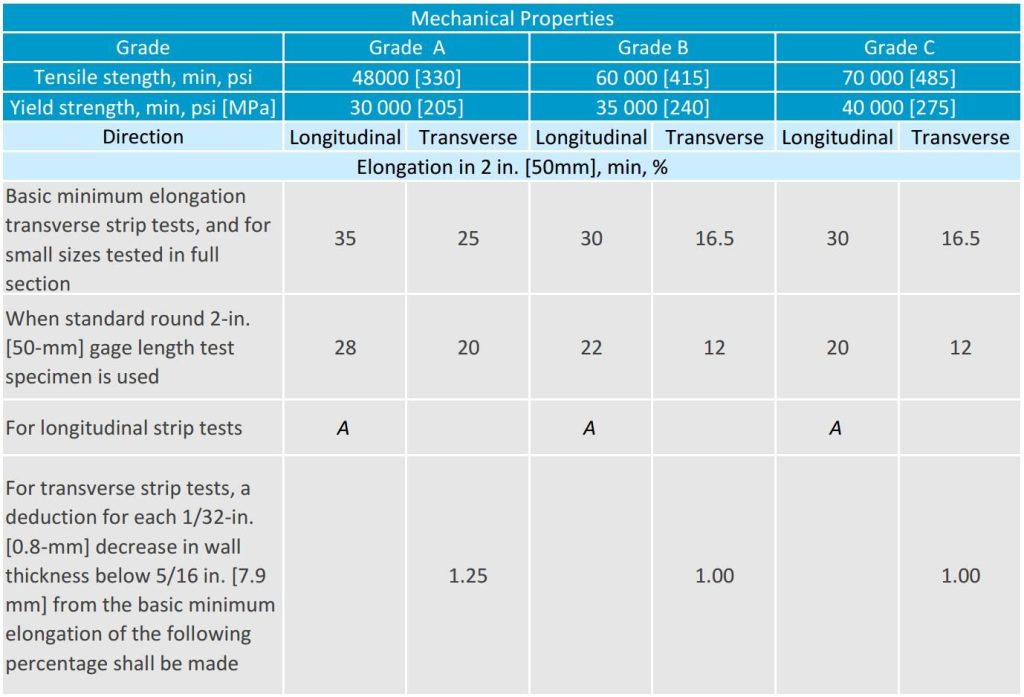The application of ASTM A106 and ASME SA106 seamless pressure pipes is widespread across industries, including the construction of oil and gas refineries, power plants, petrochemical facilities, boilers, and ships. These pipes are essential for the efficient transportation of fluids and gases that operate at elevated temperatures and pressures.

ASTM A106/ASME SA106 serves as the standard specification for seamless carbon steel pipes designed for high-temperature applications. Comprising three grades—A, B, and C—Grade B is the most commonly utilized. This type of piping plays a crucial role across various industries, serving in pipeline systems for oil and gas, water transmission, and mineral slurry conveyance. It also contributes to boiler systems and serves construction and structural purposes.
Considered comparable to ASTM A53 Grade B and API 5L Grade B in terms of chemical composition and mechanical properties, ASTM A106 Grade B pipe is a form of carbon steel boasting a minimum yield strength of 240 MPa and a minimum tensile strength of 415 MPa.
In the subsequent sections, we will delve into different facets of ASTM A106 Grade B pipe:
Chemical Makeup and Mechanical Strength
The Chemical Composition of ASTM A106 Grade B and A Pipes

Chemical composition in %
- Carbon (C) Max For Grade A 0.25, For Grade B 0.30, Grade C 0.35
- Manganese (Mn): 0.27-0.93, 0.29-1.06
- Sulfur (S) Max: ≤ 0.035
- Phosphorus (P) : ≤ 0.035
- Silicon (Si) Min : ≥0.10
- Chrome (Cr): ≤ 0.40
- Copper (Cu): ≤ 0.40
- Molybdenum (Mo): ≤ 0.15
- Nickel (Ni): ≤ 0.40
- Vanadium (V): ≤ 0.08
Important Considerations: It's important to highlight that with each decrease of 0.01% in the maximum carbon content, there is an allowable increase of 0.06% in manganese above the specified threshold, reaching a maximum limit of 1.35%.
Additionally, the combined content of chromium (Cr), copper (Cu), molybdenum (Mo), nickel (Ni), and vanadium (V) should not surpass 1%.
ASTM A106 Grade B Tensile Strength and Yield Strength

Elongation Calculation: The formula for elongation, measured in 2 inches [50mm], is determined by the equation: e = 625,000 A^0.2 / U^0.9. For inch-pound units, the formula is e = 1940 A^0.2 / U^0.9.
Detailed explanations for the variables e, A, and U can be found here. (The equation is identical to that used in ASTM A53 and API 5L pipe standards.)
Minimum Tensile Strength, psi [MPa]:
- Grade A: 48,000 [330]
- Grade B: 60,000 [415]
- Grade C: 70,000 [485]
Minimum Yield Strength, psi [MPa]:
- Grade A: 30,000 [205]
- Grade B: 35,000 [240]
- Grade C: 40,000 [275]
Minimum Elongation in 2 inches (50mm), percentage %: For all small sizes tested in full section, the basic minimum elongation in transverse trip tests is as follows:
- Grade A: Longitudinal 35, Transverse 25
- Grade B: Longitudinal 30, Transverse 16.5
- Grade C: Longitudinal 30, Transverse 16.5
If a standard round 2-inch gage length test sample is used, the corresponding values are:
- Grade A: 28, 20
- Grade B: 22, 12
- Grade C: 20, 12.
Standards Referenced in the Production of ASTM A106 Pipes
References to ASTM standards include:
a. ASTM A530/A530M: Specifies common requirements for carbon and alloy pipes.
b. E213: Sets the standard for the Ultrasonic Examination test.
c. E309: Establishes the standard for the Eddy Current examination test.
d. E381: Outlines the standard for the Macroetch test plan, applicable to steel products such as steel bars, billets, blooms, and forging steels.
e. E570: Defines the standard for the flux leakage test plan for ferromagnetic steel pipes and pipeline products.
Additional Standards:
f. ASME B 36.10M: Specifies nominal sizes for welded and seamless steel pipes.
g. MIL-STD-129: Governs the markings for shipment and storage in military applications.
h. MIL-STD-163: Dictates the standards for the storage and shipment of steel forging products in military contexts.
i. Fed. Std. No. 123: Establishes standards for marking and shipments for civil agencies.
j. Fed. Std. No. 183: Specifies continuous ID marking for steel products.
k. Surface Standard: l. SSPC-SP 6: Defines the standard for surface preparation.

Grade B Seamless Pipe
The ASTM A106 standard outlines specifications for seamless steel pipes, comprising three grades: ASTM A106 Gr. A, Gr. B, and Gr. C. Enhanced strength performance is achieved with higher-grade materials.
Testing Procedures Test methods for ASTM A106 grades A, B, and C encompass flattening tests, hydrostatic tests, nondestructive electric tests, ultrasonic tests, eddy current tests, and flux leakage tests. It is essential to discuss and confirm these testing procedures with the client to identify the specific tests that will be implemented.
Our Supply Range for Sale
CG provides seamless carbon steel pipes of ASTM A106 Grade A, Grade B, and Grade C, meeting the following specifications:
- Standard: ASTM A106, Nace, Sour service.
- Grade: A, B, C
- Outer Diameter Range: NPS 1/8 inch to NPS 20 inch, 10.13mm to 1219mm
- Wall Thickness Range: SCH 10, SCH 20, SCH STD, SCH 40, SCH 80, to SCH160, SCHXX; 1.24mm up to 1 inch, 25.4mm
- Length Range: 20ft to 40ft, 5.8m to 13m, single random lengths of 16 to 22ft, 4.8 to 6.7m, double random length with an average of 35ft, 10.7m
- Ends Processing: Plain end, beveled, threaded Coating: Black paint, varnished, epoxy coating, polyethylene coating, FBE and 3PE, CRA Clad and Lined.








